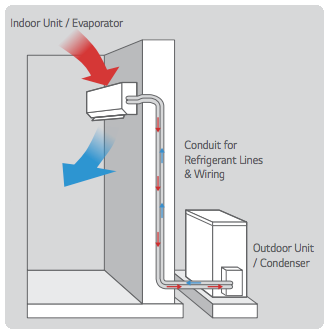Significance of Ventilation in Air Conditioned Houses- Especially during pandemic
The Covid Pandemic made everyone to think deeply - how to save ourselves. There are numerous social media sermons advocating various preventive measures. The one I am just bringing out here is the importance of proper ventilation in places we love - houses and Offices.

The Same Inside Air is recirculated time and again with a Home AC. This improves the efficiency of the System, but once in a while we need to let the fresh air in - otherwise we are breathing in the same stale Air. Split or Window ACs don't ventilate the rooms.
Irrespective of the Covid scare, the requirement of proper ventilation was , is and will always be there. Stagnant air has increased pollutants and viruses like stagnant water which can be a breeding ground for mosquitoes. Few studies suggest that Air polluntion inside houses is as severe as Pollution outside. Here I am sharing two articles on Times of India, highlighting the importance of ventilation and how lack of it is causing health aliments -
1. Sick building syndrome triggers viral attacks in Kolkata - This 2013 article of Times of India highlights how the problem of Poor ventilation had resulted in increased viral attacks in Kolkata. An excerpt from the articles - A study by physicians in Kolkata reveals that less than 40% of offices in Kolkata had proper ventilation. It also shows that people working in cramped, air-conditioned offices were more vulnerable to bacterial infections.
2. 9 hours in an AC workplace may be disastrous - Similar article of 2013 from Times of India. This time from Mumbai. This article also highlights the problem wit Non Ventilated Air Conditioned Space. Excerpts from the Article - The hitch, of course, is that most urban residents end up spending close to nine hours a day in air-conditioned offices, often following it up with a whole night’s sleep in closed, cool bedrooms. Your lungs are the first hit, which is why respiratory infections including common cold, frequent headaches, itchy throat and symptoms of flu, are most common among young, urban professionals. Fresh air that helps the lung’s airways to dilate, releasing airborne toxins from your system, is scant in swanky AC offices.
Solution
Above article sounds logical and emphasis the need for proper ventilation. A flowing Air flushes the polluntants inside the houses. So how to ventilate properly. I am presenting here two informations. One by Manufacturer of Airconditioners . Daikin and another guidelines distributed by Indian Society of Heating, Refrigerating & Air Conditioning Engineers (Ishrae).
1. How to Ventilate well This article clearly tells that Split ACs doesn't ventilate the room and suggests to open diagonal windows for 5 to 10 minutes every one hour. Big centralized units generally draw fresh air but house AC s don't ventilate.
2. Ishrae Covid Guidelines - Click Here for the PDF
Room air conditioners re-circulate air within a single occupied zone. Capacities vary from 1 to 3 TR (Tons of Refrigeration). Installed for a single room application, the entry of occupants into such spaces is controllable.
Recirculation of cool air by Room Air conditioners, must be accompanied by outdoor air intake through slightly open windows and exhaust by natural exfiltration. Fresh Air intake through a fan filter unit will prevent outdoor dust entry (containing high levels of PM 10 and PM 2.5 particles) and exhaust through kitchen and toilet exhaust fans kept operational.
Set Room Temperature between 24°C and 30°C. Maintain relative humidity between 40% and 70%. (In humid climates set temperature closer to 24°C for de humidification and in dry climates closer to or at 30°C and use fans to increase air movement).
In dry climates, do not allow Relative Humidity to fall below 40% . Water evaporating from a pan kept in the room will increase humidity if it falls below 40%.
Whether it is Covid or No-Covide it is better to improve the ventilation in our Closed Spaces for overall well being. Disclaimer - This intention of this article is only to collect the ready available information and present for general information. It is not for any diagnosis or treatments.
